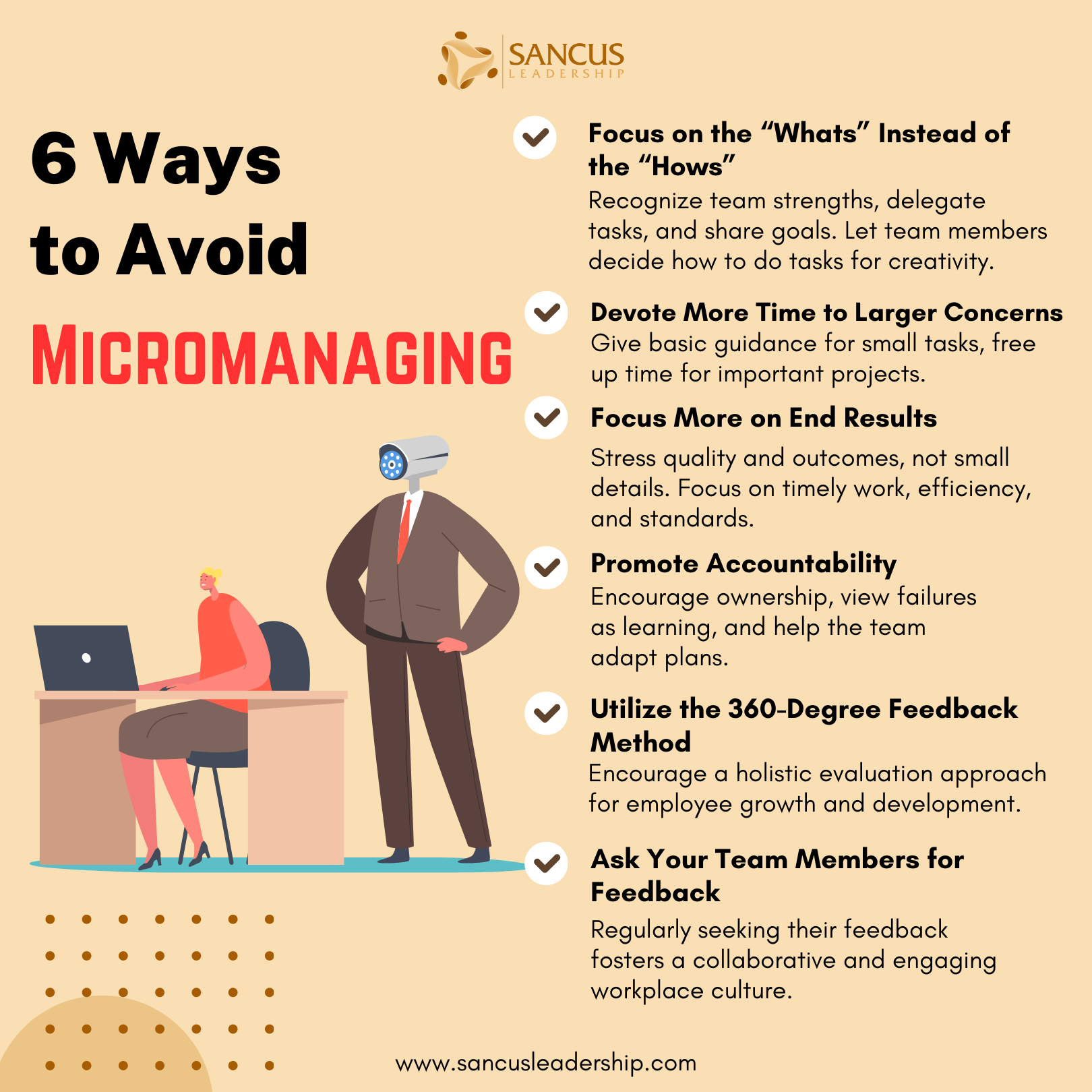Your cart is currently empty!

What Is Micromanaging? (Are You Doing It?)
Are you looking over your employees’ shoulders and feeling suspicious if their skills are up to par? Are you stressed daily with following up on tasks, ensuring the quality of work delivered, meeting deadlines, and keeping everyone in line? If so, you might be a micromanager.
Micromanaging is a leadership style where leaders insist on having complete control over every aspect of the team, including how employees accomplish tasks. They pay extreme attention to details, even the smallest ones. This often results in losing track of what’s truly essential in business.
Let’s take a closer look at what micromanaging is really all about and whether or not it’s good for business. If you aren’t sure about it, I’ve provided some telltale behavioral practices and habits of micromanagers to help you identify if you’re one. Then, I’ve got some helpful tips to guide you in tempering your micromanaging tendencies so you can work toward becoming the best leader.
Is Micromanaging Really All That Bad?

Micromanaging is typically associated with distrust in the team, an autocratic style of leadership, and a lack of freedom in the workplace. Micromanagers closely control, observe, and dictate their team members’ next moves. Excessive and unwarranted supervision includes criticizing or commenting on every little detail involved in daily tasks.
Some leaders choose this stringent approach in managing their team because it elicits immediate responses and produces fast results. However, this leadership style often creates a hostile work environment, thus jeopardizing efficiency, collaboration, and productivity.
On the other hand, some employees favor this leadership style because constant guidance and close monitoring push them to perform better at their jobs. They also like being told exactly what to do instead of devising strategies on their own. They believe this saves precious time because they no longer have to wait for approvals from their leaders and won’t have to worry about things going wrong since every detail is their leader’s idea anyway.
Micromanagement is seen negatively because it usually creates a hostile atmosphere in the workplace where employees may feel indignant that their leaders don’t feel confident about their abilities and competencies. At the other end of the spectrum, some employees might start questioning their capabilities and lose self-confidence.
The Dangers of Micromanaging
Here are some of the most adverse effects of a micromanaging leadership style:
- It may pull down the team’s morale.
- Team members may become resentful because they feel they’re always undermined.
- Employees may frequently feel demotivated and frustrated since they feel their growth in the company is stunted.
- It obstructs an employee’s individuality and opportunity to shine since the leader always interferes with their affairs.
- It puts a damper on creativity, innovation, and initiative and may practically suck the life out of an otherwise thriving, diverse, and collaborative organization.
When Is Micromanaging Okay?
Micromanaging can be advantageous to the business if it is employed in the right circumstances and in the proper manner.
Here are some scenarios where micromanagement may yield positive results for your business:
- When employees have recently joined the company, and you’re keen on ensuring that they quickly adapt to your system and standards.
- When the project at hand is more complicated than usual or is completely new to the team.
- When critical decisions have to be made, and crucial tasks have to be executed flawlessly.
- When you detect an alarmingly rapid decline in the team’s productivity or quality of work delivered.
- When the organization or industry is in the middle of a crisis.
- When your team has been constantly missing deadlines.
- When you’re aiming to resolve a small issue so it doesn’t escalate into a catastrophic problem.
- When your clients have recently been giving unfavorable feedback on your team’s performance.
| The Dangers of Micromanaging | When Is Micromanaging Okay? |
| 1. It may pull down the team’s morale. | 1. When employees have recently joined the company, and you’re keen on ensuring that they quickly adapt to your system and standards. |
| 2. Team members may become resentful because they feel they’re always undermined. | 2. When the project at hand is more complicated than usual or is completely new to the team. |
| 3. Employees may frequently feel demotivated and frustrated since they feel their growth in the company is stunted. | 3. When critical decisions have to be made, and crucial tasks have to be executed flawlessly. |
| 4. It obstructs an employee’s individuality and opportunity to shine since the leader always interferes with their affairs. | 4. When you detect an alarmingly rapid decline in the team’s productivity or quality of work delivered. |
| 5. It puts a damper on creativity, innovation, and initiative and may practically suck the life out of an otherwise thriving, diverse, and collaborative organization. | 5. When the organization or industry is in the middle of a crisis. |
| 6. When your team has been constantly missing deadlines. | |
| 7. When you’re aiming to resolve a small issue so it doesn’t escalate into a catastrophic problem. | |
| 8. When your clients have recently been giving unfavorable feedback on your team’s performance. |
Signs That You’re a Micromanager

You might not be aware of it because your behaviors and standards as a leader have been part of your strategy for managing your team for quite some time now, but identifying your leadership style is crucial to ensuring that it is effective and capable of yielding your desired results.
Here are some signs that might indicate you’re micromanaging your team:
- You spend most of your day monitoring your team members, sometimes reaching the point where you overlook your own tasks.
- You dwell too much on details, even if they’re inconsequential.
- You want to be informed and updated about every little change or development.
- You take over other people’s tasks because you believe you can do them better.
- You tell your employees what to do and how to do it (sometimes, you even show them how).
- You dominate meetings, frequently talking over everyone else.
- You demand that tasks be redone when they weren’t executed in the exact way you wanted.
- You eagerly take credit for good results but obstinately and decisively shift the blame to your employees when the outcome isn’t favorable.
- Your aggression toward your employees can often be deemed as workplace bullying.
- You tend to be overly sensitive to criticisms ( even if they’re constructive), and you take these assumed offenses personally.
- You generally don’t want to hear about other people’s feelings, ideas, or insights because you see these as immaterial in business.
- You overly criticize your team members.
Why Some Leaders Micromanage
Micromanaging usually stems from the individual’s personality, character, and disposition. Some leaders are innately controlling and domineering, while others are more laid back. Some leaders may feel unsure of themselves and their team, while others may worry that their status in the company heavily relies on their team’s productivity.
Here are some of the usual causes of micromanagement in leadership:
- Lack of trust in their employees. This may be due to the leader’s lack of confidence in their employees’ skills and depth of experience. Perhaps previous experiences also made them realize that their employees’ standards are much lower than theirs.
- Insecurity about their position in the organization. Some leaders fear their role in the organizational hierarchy will be compromised if their team members don’t deliver top-quality work. They find comfort in ensuring that the failures of their team members won’t be associated with them.
- Loss of recognition. Some leaders worry that if they don’t fully control their employees, any exceptional work will reflect only on the individual, and their contributions will be completely disregarded.
- Narcissism. Narcissistic traits are commonly observed in the most successful leaders; some micromanage to satisfy their egos. They rarely consider other people’s perspectives because they believe their insights are the most accurate and reliable.
- Perfectionism. These leaders hold themselves to impossibly high standards and expect their team to do so, too. They are extremely organized and structured. It may be a potent motivator, but sometimes, perfectionism can make you (and others) feel constantly discontented and unhappy.
How to Master Your Micromanaging Tendencies

When all is said and done, micromanaging can be highly detrimental to your business. It’s essential that you use this leadership style only when necessary and only on team members who will truly benefit from it.
Here are some tips on how you can get a grip on your micromanaging tendencies so they don’t hamper your team’s creativity and initiative and impede your business’ efficiency and productivity:

1. Focus on the “Whats” Instead of the “Hows”
Identify your team members’ strengths so you know how to delegate tasks appropriately. Tell them what output is expected, then take a step back and give them the freedom to decide how best to execute their tasks.
Giving your employees autonomy will empower them to make smart decisions for the business. It will encourage them to unleash their creative side and bring new perspectives and strategies to the table that may otherwise be inaccessible to the team.
Giving your employees autonomy will empower them to make smart decisions for the business.
2. Devote More Time to Larger Concerns
Give your team members general instructions for smaller projects, then give them the freedom to execute these tasks appropriately. Don’t sweat the small stuff, and allow them to plan their day and make decisions independently.
This way, you can spend your time tracking other tasks, offering guidance to more team members, and paying closer attention to more significant, more critical projects.
3. Focus More on End Results
Rather than stressing yourself (and your team members) about procedural technicalities, emphasize work quality, overall performance, and end results more.
Are my team’s tasks accomplished on time?
Do my team members execute tasks efficiently?
Are the end results at par with company standards?
If your answer to these questions is a resounding yes, then there is no longer use fussing over minute details. Focusing on irrelevant and inconsequential matters only muddles true objectives, causes delays in the execution of tasks, and restricts employees from exercising their initiative, proficiency, and creativity in getting their jobs done.
4. Promote Accountability
Encourage your team members to take ownership of their work, and make sure this starts with you. Stop making such a big fuss about shortcomings and failure all the time. Learn to accept that these are part of the learning process and can be used as building blocks for improvement and progress.
Encourage your team members to take ownership of their work, and make sure this starts with you.
Encourage your team to devise alternative plans of action when their original plan doesn’t deliver the expected results. Make them feel more comfortable with failure so they don’t see it as a dead end on the road to success.
I remember when a friend shared how a team leader, Lorie, in a company she used to work with would always brush failures off with a smile and then proceed to say her infamous line, “So, what should we do about this?” Everyone in the organization loved this about her. She didn’t dwell on the negatives but instead focused on how she could help turn the negatives into positives.
Lorie’s team members never felt like they had to walk on eggshells around her, even when they felt like their devised plans and strategies were bound to fail. They never felt reluctant about approaching her for help. They saw their leader as an ally in the organization — not just a superior tasked to oversee their affairs, ensure everything was in order, and castigate them when things went wrong.
Lorie’s mindset about taking ownership of one’s work quickly rubbed off on all her team members. Her team was known for being always positive, engaged, collaborative, and productive even during instances when things didn’t go as they originally planned.
5. Utilize the 360-Degree Feedback Method
Constructive criticisms are essential in helping an individual grow and develop professionally. To make your appraisals even more effective, always employ the 360-Degree Feedback Method. Rather than relying on a one-way street type of arrangement, this method opens up all avenues for your employees. Hence, they enjoy the benefits of a more holistic approach to evaluating the quality of their work.
Typically, leaders rely on a standard process where they are the sole source of feedback for their team members. They critique their employees with statements such as:
“I’m impressed with your output. Great job!”
“You could’ve done some extra research to make your report more current.”
“I’m worried your clients might find this report lacking in relevance.”
“Our IT department might have trouble analyzing this data.”
Such statements may be helpful, but they rely on the insights, perceptions, and interpretations of just one person. With the 360-Degree Feedback Method, assessments from peers, leaders, clients, suppliers, and practically everyone involved in the business are taken into account.
6. Ask Your Team Members for Feedback
Leaders are used to always providing feedback to their employees, so it would be quite refreshing if the tables were turned when it comes to assessing your brand of leadership. By asking for their evaluation, insights, and criticisms, you are essentially telling them that you value their opinions and are keen on considering their perspectives on various issues.
Doing this regularly will help build your team’s sense of belonging — they will feel that they’re valued and appreciated, prompting them to share more of their ideas and insights. This helps create a collaborative and engaging culture in the workplace where your team members become your allies in business.
Chieh Huang, in this funny and wisdom-packed TED talk, shares his insights on micromanagement and the importance of fostering innovation and happiness at work.
Final Thoughts
Micromanaging is typically seen as an iron-fisted type of leadership where the leader’s insights always take precedence over their employees’. It may cause damage to a team’s morale and productivity.
However, when executed under proper circumstances, micromanagement can help your team become more efficient and productive, hence becoming significant contributors to the business’ drive toward success.
If you think you’re a micromanager and need some help refining your methods, reach out, and we’ll talk about strategies you can employ that are more beneficial for your business. We, at Sancus Leadership, can help you tailor-fit your management style to your team’s unique needs.
